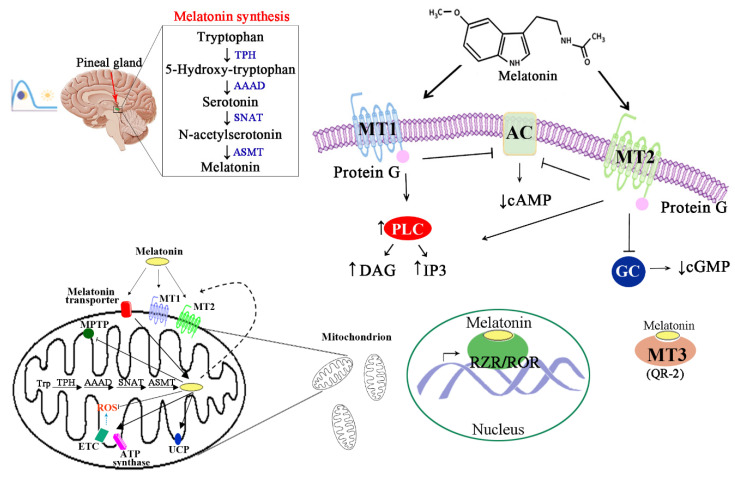Figure 1.
Melatonin biosynthesis and intracellular signal-transduction pathways activated by stimulation of melatonin specific receptors. The picture shows: (figure top left) the intracerebral site of melatonin biosynthesis, that is the pineal gland, the melatonin biosynthetic pathway, and the influence of light and photoperiod change on melatonin biosynthesis; (figure bottom left) mitochondrial melatonin biosynthesis and local action: melatonin is synthesized within mitochondrial matrix, but it can also enter the mitochondria through a specific transporter; melatonin activates specific MT1 and MT2 receptors on mitochondrial outer membrane, also in an autocrine way, inhibits MPTP and ROS production, and stimulates ETC and UCP; (figure right) melatonin interaction with its specific MT1 and MT2 receptors and RZR/ROR orphan nuclear receptors, and activation of different metabolic pathways. AAAD, aromatic L-amino acid decarboxylase; AC, adenylate cyclase; AFMK, N1-acetyl-N2-formyl-S-methoxykynuramine (melatonin metabolite); ASMT, N-acetylserotonin O-methyltransferase; cAMP, cyclic adenosine monophosphate; cGMP, cyclic guanosine monophosphate; DAG, diacylglycerol; ETC, electron transfer chain; GC, guanylate cyclase; IP3, inositol triphosphate; MPTP, mitochondrial permeability transition pore; MT1-MT3, melatonin specific receptor 1, 2, 3; PLC, phospholipase C; QR-2, quinone reductase 2; ROS, reactive oxygen species; RZR/ROR, retinoid Z receptor/retinoid acid receptor-related orphan receptor; SNAT, serotonin N-acetyltransferase; TPH, tryptophan hydroxylase; UCP, uncoupling protein.

